Director: H Tjut Djalil
Writer: Jimmy Atmaja
Producers: Abdul Muis Sofian, Hendry Katili, Sri Gunawan
Cast: Ilone Agathe Bastian, Yos Santo, Itje Trisnawati
Year of release: 1981
Country: Indonesia
Reviewed from: UK DVD (Mondo Macabro)
You can’t go wrong with Indonesian horror movies - they’re unashamedly bonkers. Mystics in Bali is allegedly one of the best - for some value of best - and is another terrific presentation from Mondo Macabro, purveyors of international weirdness to the discerning cinephile.
German tourist Ilone Agathe Bastian stars as American Kathy Keen. I’ll just repeat that in case you think you must have misread it - the female lead in this film is played not by an Indonesian actress, not by an American actress, not even by the director’s girlfriend but by a passing German tourist! This is the quality of film-making we’re dealing with.
Yos Santo - a skinny bloke with bushy hair and a small moustache - plays her Indonesian friend Mahendra. Kathy wants to write a book about black magic and Mahendra somehow introduces her to a master of the strongest, most primitive magic known to man - Leak (or Leyak). This turns out to be a mad old crone, all long fingernails, straggly hair and tatty clothes (not unlike the basic appearance of the evil sorcerer in Pemuja Cakar Iblis). The crone reappears in various guises, gradually getting younger, but the main thing she does is laugh. She positively screeches, over and over again (you can hear a mercifully brief clip of it at the end of the title sequence of the Mondo Macabro TV series, of which the episode about Indonesian movies is included here).
Our first touch of weirdness is when the crone shakes hands with Kathy and departs, leaving her detached hand which scuttles off when Kathy drops it to the ground. Over time Kathy learns more and more leyak magic from the ‘Leyak Queen’ and comes more and more under her power, to the consternation of Mahendra and his uncle, who once fought a leyak wizard (or something).
![]() The young couple’s second meeting with the crone is extremely odd, and not just because we cut from one night scene to another with no indication that it’s 24 hours later. The witch is unseen this time, hiding in a bush, from which extends a slightly forked ten-foot tongue. “Have you brought the things I asked you to bring?” she asks, despite not having asked them to bring anything. And indeed they have - some small jewels and about eight pints of blood in glass bottles. No, it’s not explained...
The young couple’s second meeting with the crone is extremely odd, and not just because we cut from one night scene to another with no indication that it’s 24 hours later. The witch is unseen this time, hiding in a bush, from which extends a slightly forked ten-foot tongue. “Have you brought the things I asked you to bring?” she asks, despite not having asked them to bring anything. And indeed they have - some small jewels and about eight pints of blood in glass bottles. No, it’s not explained...
Leyak magic gives its practitioners the ability to transmogrify themselves and we see this in action when the two women (Kathy having learned to screech with laughter properly) turn into pigs. This is achieved initially by crude bladder effects on their faces, then showing them running around wearing - I am not making this up - inflatable pig costumes. They then drop to all fours and, by the miracle of crap editing, become genuine live pigs.
That’s all well and good, but you can see crawling disembodied hands and people turned into pigs anytime (try a double bill of The Addams Family and Time Bandits). About halfway into the 80-minute feature we get what we’ve been waiting for, the image promised on the sleeve and the disc menu: Kathy’s disembodied floating head, complete with internal organs suspended beneath it.
![]() The crone/witch/woman/thing wants Kathy’s head to do her evil work and sends it flying off through a mix of blue-screen work and a prop on a wire. Unwitting accomplice Kathy develops big vampire fangs when her noggin detaches and goes off to munch down on a baby as it’s being born - although the camera angle frankly makes this scene look more like lesbian muff-diving. Sorry, but it does.
The crone/witch/woman/thing wants Kathy’s head to do her evil work and sends it flying off through a mix of blue-screen work and a prop on a wire. Unwitting accomplice Kathy develops big vampire fangs when her noggin detaches and goes off to munch down on a baby as it’s being born - although the camera angle frankly makes this scene look more like lesbian muff-diving. Sorry, but it does.
Later we see the two women transform again - into snakes. Yes, Mystics in Bali is another snake-woman film, though it only just scrapes into that increasingly prolific genre because they’re not ‘snake-women’ per se, just women who can turn into animals, including on one occasion snakes. However, on the plus side the extras include an image of a poster for a movie called The Hungry Snake Woman (starring Indonesian horror legend Suzzanna) which clearly is a version of ‘The Snake King’s Daughter’. Another one to try and track down...
Mahendra’s uncle meanwhile knows that the best way to defeat the monster that Kathy has become is to prevent her guts-dangling head from reattaching to her body. This leads to the traditional climactic magical fight, yada yada yada.
It’s slow to start but once it gets going Mystics in Bali is top quality trash (there’s a bit of travelogue-style footage of Indonesian dancing early on to tempt tourists, though any promotional effort is rather undone by the suggestion that the country is home to cackling witches and flying vampire heads). The special effects are surprisingly sophisticated until one realises that what looks like an early 1970s movie was actually made in 1981. The best effect is in the final battle when the witch and the uncle fire animated bolts of energy at each other, tipped with grasping claws. Which is quite cool. (For a better, CGI-based flying vampire head effect, check out the 2002 Thai film Demonic Beauty.)
The dubbing is diabolical, with Mahendra in particular falling. Into the William. Shatner school of. Unnecessary pauses. Mondo Macabro’s print comes from the original negative and looks far better than the film deserves. It’s a terrific widescreen transfer with a bit of scratching, especially at reel ends, and the colour on some of the night scenes is a tad screwy, but that really doesn’t detract from the hoopla on screen.
As extras we get the aforementioned 25-minute documentary, which includes interviews with the director, special effects bloke El Badrun (who is clearly bonkers) and various producers and actors - including the living legend that is Barry Prima. There are clips from The Warrior, Satan’s Slave (no, not the Norman J Warren film!) and one of my all-time favourite pieces of Asian lunacy, The Devil’s Sword - directed by the aforementioned Mr Badrun! There’s an excellent and very informative essay on Mystics and its place in Indonesian exploitation cinema, and even an article on ‘how to become a leyak practitioner’ which reads like it has been copied from an old book, but unfortunately neither essay nor article are credited. There’s a complete filmography of director H Tjut Djalil (Lady Terminator) too.
![]() Mystics in Bali is the on-screen title here but the film was apparently released as Balinese Mystic in Australia, a more likely location of potential tourists. Djalil does say in the documentary that the lead character is Australian and this is reinforced by a bit of poster copy reproduced on the IMDB, although the dialogue is unequivocal about Kathy being from the USA, which raises the possibility that the Aussie retitling might indicate a completely different dub. The other title sometimes given for the film is Leak, presumably used domestically. It is based on a novel called Leak Ngakak by local author Putra Mada.
Mystics in Bali is the on-screen title here but the film was apparently released as Balinese Mystic in Australia, a more likely location of potential tourists. Djalil does say in the documentary that the lead character is Australian and this is reinforced by a bit of poster copy reproduced on the IMDB, although the dialogue is unequivocal about Kathy being from the USA, which raises the possibility that the Aussie retitling might indicate a completely different dub. The other title sometimes given for the film is Leak, presumably used domestically. It is based on a novel called Leak Ngakak by local author Putra Mada.
Who would have thought that a film like this, in a terrific presentation and with an excellent bunch of extra goodies, would ever be for sale on the British high street? What an odd world we live in. Anyone with a fondness for Pacific Rim insanity should buy a copy of this straightaway. It’s a truly terrible film, but it is an absolute must-see. And if it sells enough, perhaps Mondo Macabro will release a similarly well-transferred and well-packaged version of The Devil’s Sword so that I can ditch my battered old ex-rental VHS copy.
MJS rating: A-
Writer: Jimmy Atmaja
Producers: Abdul Muis Sofian, Hendry Katili, Sri Gunawan
Cast: Ilone Agathe Bastian, Yos Santo, Itje Trisnawati
Year of release: 1981
Country: Indonesia
Reviewed from: UK DVD (Mondo Macabro)
You can’t go wrong with Indonesian horror movies - they’re unashamedly bonkers. Mystics in Bali is allegedly one of the best - for some value of best - and is another terrific presentation from Mondo Macabro, purveyors of international weirdness to the discerning cinephile.
German tourist Ilone Agathe Bastian stars as American Kathy Keen. I’ll just repeat that in case you think you must have misread it - the female lead in this film is played not by an Indonesian actress, not by an American actress, not even by the director’s girlfriend but by a passing German tourist! This is the quality of film-making we’re dealing with.
Yos Santo - a skinny bloke with bushy hair and a small moustache - plays her Indonesian friend Mahendra. Kathy wants to write a book about black magic and Mahendra somehow introduces her to a master of the strongest, most primitive magic known to man - Leak (or Leyak). This turns out to be a mad old crone, all long fingernails, straggly hair and tatty clothes (not unlike the basic appearance of the evil sorcerer in Pemuja Cakar Iblis). The crone reappears in various guises, gradually getting younger, but the main thing she does is laugh. She positively screeches, over and over again (you can hear a mercifully brief clip of it at the end of the title sequence of the Mondo Macabro TV series, of which the episode about Indonesian movies is included here).
Our first touch of weirdness is when the crone shakes hands with Kathy and departs, leaving her detached hand which scuttles off when Kathy drops it to the ground. Over time Kathy learns more and more leyak magic from the ‘Leyak Queen’ and comes more and more under her power, to the consternation of Mahendra and his uncle, who once fought a leyak wizard (or something).
 The young couple’s second meeting with the crone is extremely odd, and not just because we cut from one night scene to another with no indication that it’s 24 hours later. The witch is unseen this time, hiding in a bush, from which extends a slightly forked ten-foot tongue. “Have you brought the things I asked you to bring?” she asks, despite not having asked them to bring anything. And indeed they have - some small jewels and about eight pints of blood in glass bottles. No, it’s not explained...
The young couple’s second meeting with the crone is extremely odd, and not just because we cut from one night scene to another with no indication that it’s 24 hours later. The witch is unseen this time, hiding in a bush, from which extends a slightly forked ten-foot tongue. “Have you brought the things I asked you to bring?” she asks, despite not having asked them to bring anything. And indeed they have - some small jewels and about eight pints of blood in glass bottles. No, it’s not explained...Leyak magic gives its practitioners the ability to transmogrify themselves and we see this in action when the two women (Kathy having learned to screech with laughter properly) turn into pigs. This is achieved initially by crude bladder effects on their faces, then showing them running around wearing - I am not making this up - inflatable pig costumes. They then drop to all fours and, by the miracle of crap editing, become genuine live pigs.
That’s all well and good, but you can see crawling disembodied hands and people turned into pigs anytime (try a double bill of The Addams Family and Time Bandits). About halfway into the 80-minute feature we get what we’ve been waiting for, the image promised on the sleeve and the disc menu: Kathy’s disembodied floating head, complete with internal organs suspended beneath it.
 The crone/witch/woman/thing wants Kathy’s head to do her evil work and sends it flying off through a mix of blue-screen work and a prop on a wire. Unwitting accomplice Kathy develops big vampire fangs when her noggin detaches and goes off to munch down on a baby as it’s being born - although the camera angle frankly makes this scene look more like lesbian muff-diving. Sorry, but it does.
The crone/witch/woman/thing wants Kathy’s head to do her evil work and sends it flying off through a mix of blue-screen work and a prop on a wire. Unwitting accomplice Kathy develops big vampire fangs when her noggin detaches and goes off to munch down on a baby as it’s being born - although the camera angle frankly makes this scene look more like lesbian muff-diving. Sorry, but it does.Later we see the two women transform again - into snakes. Yes, Mystics in Bali is another snake-woman film, though it only just scrapes into that increasingly prolific genre because they’re not ‘snake-women’ per se, just women who can turn into animals, including on one occasion snakes. However, on the plus side the extras include an image of a poster for a movie called The Hungry Snake Woman (starring Indonesian horror legend Suzzanna) which clearly is a version of ‘The Snake King’s Daughter’. Another one to try and track down...
Mahendra’s uncle meanwhile knows that the best way to defeat the monster that Kathy has become is to prevent her guts-dangling head from reattaching to her body. This leads to the traditional climactic magical fight, yada yada yada.
It’s slow to start but once it gets going Mystics in Bali is top quality trash (there’s a bit of travelogue-style footage of Indonesian dancing early on to tempt tourists, though any promotional effort is rather undone by the suggestion that the country is home to cackling witches and flying vampire heads). The special effects are surprisingly sophisticated until one realises that what looks like an early 1970s movie was actually made in 1981. The best effect is in the final battle when the witch and the uncle fire animated bolts of energy at each other, tipped with grasping claws. Which is quite cool. (For a better, CGI-based flying vampire head effect, check out the 2002 Thai film Demonic Beauty.)
The dubbing is diabolical, with Mahendra in particular falling. Into the William. Shatner school of. Unnecessary pauses. Mondo Macabro’s print comes from the original negative and looks far better than the film deserves. It’s a terrific widescreen transfer with a bit of scratching, especially at reel ends, and the colour on some of the night scenes is a tad screwy, but that really doesn’t detract from the hoopla on screen.
As extras we get the aforementioned 25-minute documentary, which includes interviews with the director, special effects bloke El Badrun (who is clearly bonkers) and various producers and actors - including the living legend that is Barry Prima. There are clips from The Warrior, Satan’s Slave (no, not the Norman J Warren film!) and one of my all-time favourite pieces of Asian lunacy, The Devil’s Sword - directed by the aforementioned Mr Badrun! There’s an excellent and very informative essay on Mystics and its place in Indonesian exploitation cinema, and even an article on ‘how to become a leyak practitioner’ which reads like it has been copied from an old book, but unfortunately neither essay nor article are credited. There’s a complete filmography of director H Tjut Djalil (Lady Terminator) too.
 Mystics in Bali is the on-screen title here but the film was apparently released as Balinese Mystic in Australia, a more likely location of potential tourists. Djalil does say in the documentary that the lead character is Australian and this is reinforced by a bit of poster copy reproduced on the IMDB, although the dialogue is unequivocal about Kathy being from the USA, which raises the possibility that the Aussie retitling might indicate a completely different dub. The other title sometimes given for the film is Leak, presumably used domestically. It is based on a novel called Leak Ngakak by local author Putra Mada.
Mystics in Bali is the on-screen title here but the film was apparently released as Balinese Mystic in Australia, a more likely location of potential tourists. Djalil does say in the documentary that the lead character is Australian and this is reinforced by a bit of poster copy reproduced on the IMDB, although the dialogue is unequivocal about Kathy being from the USA, which raises the possibility that the Aussie retitling might indicate a completely different dub. The other title sometimes given for the film is Leak, presumably used domestically. It is based on a novel called Leak Ngakak by local author Putra Mada.Who would have thought that a film like this, in a terrific presentation and with an excellent bunch of extra goodies, would ever be for sale on the British high street? What an odd world we live in. Anyone with a fondness for Pacific Rim insanity should buy a copy of this straightaway. It’s a truly terrible film, but it is an absolute must-see. And if it sells enough, perhaps Mondo Macabro will release a similarly well-transferred and well-packaged version of The Devil’s Sword so that I can ditch my battered old ex-rental VHS copy.
MJS rating: A-
review originally posted 20th March 2005





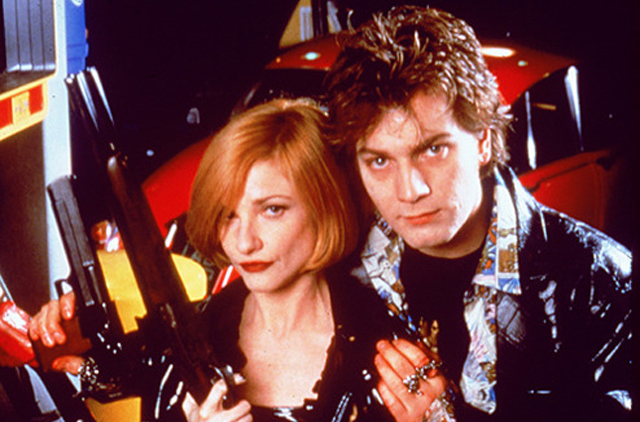


















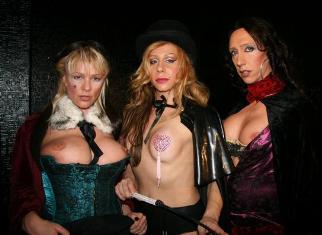











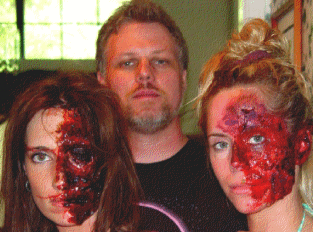
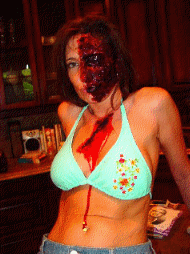
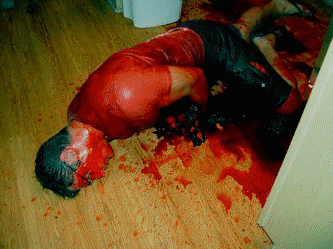





















.jpg)









